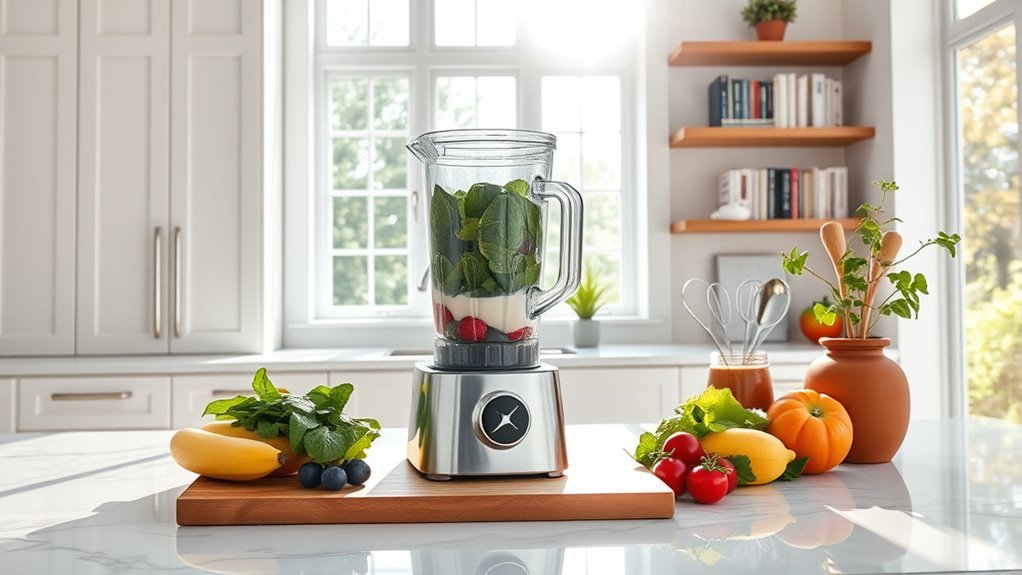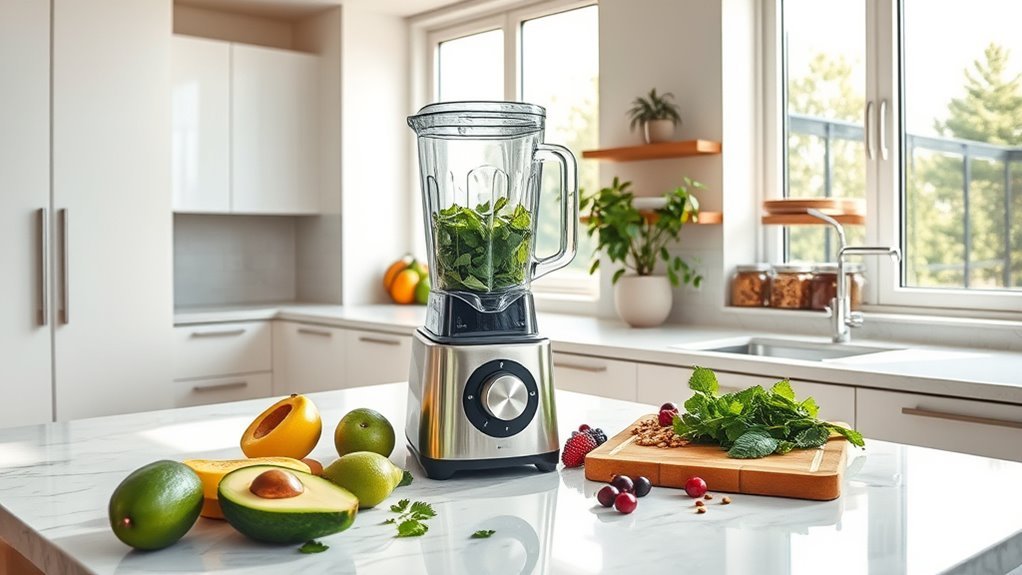For thick, chunk-free smoothies, we’ll need serious blending power. First, don’t settle for less than 1,000 watts – that’s your baseline for frozen fruits and dense greens. Second, aim for 1,500+ watts if you’re planning on daily power-packed smoothies with ice and tough ingredients. Third, remember that professional-grade blenders (1,500-2,000 watts) guarantee that silky-smooth consistency we’re after. But wattage isn’t the only factor in achieving smoothie perfection.
Minimum Wattage Requirements for Different Ingredients

When it comes to blending thick smoothies, wattage isn’t just a number – it’s your make-or-break factor.
Let’s break down the minimum wattage you’ll need for different ingredients.
For basic smoothies with soft ingredients, we can get by with 300 watts.
But don’t expect miracles with frozen fruits or ice – you’ll need at least 600-1,000 watts to crush ice and blend frozen ingredients properly.
Making thick smoothies? Look for high-performance blenders packing 1,200 watts or more.
And if you’re dreaming of homemade nut butters or ultra-thick concoctions, we’re talking 1,500+ watts.
Here’s the brutal truth: skimp on wattage, and you’ll waste precious blending time fighting with chunks in your smoothie. Higher wattage equals smooth consistency, every single time. Additionally, using a high-performance blender can significantly improve the texture of your smoothies by breaking down ingredients more effectively.
Motor Power Impact on Blending Performance
Those minimum wattage requirements lead us straight to why motor power makes or breaks your blending game.
We’ve found that blenders packing at least 1,500 watts deliver the muscle needed for thick smoothies, crushing frozen ingredients like they’re butter.
Let’s get real: High-wattage motors transform your blending performance. They’re not just crushing ice – they’re powering through dense greens and frozen fruits without breaking a sweat.
When we’re dealing with thick mixtures, that extra power prevents stalling and creates the perfect vortex action in tapered jars.
For serious smoothie makers, investing in more watts isn’t just fancy talk – it’s about consistent results. High-performance blenders offer enhanced versatility in the kitchen, making them an ideal choice for those who blend regularly.
Every time you blend, you’ll notice smoother textures and faster processing. No chunks, no struggles, just smooth sailing.
Comparing Professional Vs Home Blender Power Needs

Although professional and home blenders might look similar, they’re worlds apart in power delivery.
We’ll help you understand why professional blenders dominate thick smoothie creation, while typical home units often fall short.
- Professional blenders pack 1,500-2,000 watts of pure muscle, crushing ice and frozen fruit into silky smooth perfection without breaking a sweat.
- Standard home blenders (300-1,200 watts) struggle with dense ingredients, often leaving chunks and failing to achieve that coveted smooth texture.
- High-performance crossovers like the Vitamix 5200 (1,380 watts) bridge the gap, delivering professional-grade blending efficiency through optimized blade design and motor power.
Remember: Wattage isn’t everything.
Smart blade design and jar configuration work together with motor power to create that perfect smoothie vortex.
For thick smoothies at home, don’t settle for less than 1,000 watts.
Frequently Asked Questions
What Is the Best Blender for Thick Smoothies?
We’ve found the Vitamix Propel 510 outperforms other blender types for thick smoothies, offering perfect consistency through its 10-speed control, while the Cuisinart Hurricane Pro’s 2,000-watt power handles tough ingredients exceptionally.
What Watt Blender Is Best for Smoothies?
We recommend a 1,500+ watt blender for ideal smoothie texture and power efficiency. These high-performance models guarantee better blending speed and motor durability, though they’re typically pricier than lower-watt alternatives.
What Wattage Is Best for Smoothies?
We recommend at least 1,000 watts for best smoothie textures, with 1,500-2,200 watts being ideal for blending frozen ingredients and creating thick smoothie bowls without struggling or uneven results.
Is 600 Watts Enough for Smoothies?
We’d recommend higher wattage, as 600W struggles with smoothie consistency, especially for frozen fruits and leafy greens. While basic recipes work, you’ll need careful blending techniques and softer ingredient choices.

